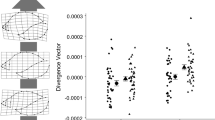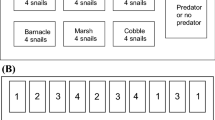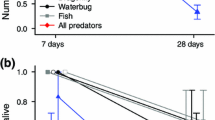Abstract
The last decade has seen an explosion in the number of studies exploring predator-induced plasticity. Recently, there has been a call for more comprehensive approaches that can identify functional relationships between traits, constraints on phenotypic responses, and the cost and benefits of alternative phenotypes. In this study, we exposed Helisoma trivolvis, a freshwater snail, to a factorial combination of three resource levels and five predator environments (no predator, one or two water bugs, and one or two crayfish) and examined ten traits including behavior, morphology, and life history. Each predator induced a unique suite of behavioral and morphological responses. Snails increased near-surface habitat use with crayfish but not with water bugs. Further, crayfish induced narrow and high shells whereas water bugs induced wide shells and wide apertures. In terms of life history, both predators induced delayed reproduction and greater mass at reproduction. However, crayfish induced a greater delay in reproduction that resulted in reduced fecundity whereas water bugs did not induce differences in fecundity. Resource levels impacted the morphology of H. trivolvis; snails reared with greater resource levels produced higher shells, narrower shells, and wider apertures. Resource levels also impacted snail life history; lower resources caused longer times to reproduction and reduced fecundity. Based on an analysis of phenotypic correlations, the morphological responses to each predator most likely represent phenotypic trade-offs. Snails could either produce invasion-resistant shells for defense against water bugs or crush-resistant shells for defense against crayfish, but not both. Our use of a comprehensive approach to examine the responses of H. trivolvis has provided important information regarding the complexity of phenotypic responses to different environments, the patterns of phenotypic integration across environments, and the potential costs and benefits associated with plastic traits.




Similar content being viewed by others
References
Abrahams MV, Healey MC (1993) A comparison of the willingness of four species of pacific salmon to risk exposure to a predator. Oikos 66:439–446
Abrams PA, Rowe L (1996) The effects of predation on the age and size of maturity of prey. Evolution 50:1052–1061
Alexander JE, Covich AP (1991a) Predation risk and avoidance behavior in two freshwater snails. Biol Bull 180:387–393
Alexander JE, Covich AP (1991b) Predator avoidance by the freshwater snail Physella virgata in response to the crayfish Procambarus simulans. Oecologia 87:435–442
Altmann J (1974) Observational study of behavior: sampling methods. Behaviour 49:227–267
Appleton R, Palmer A (1988) Water-borne stimuli released by predatory crabs and damaged prey induce more predator-resistant shell in marine gastropods. Proc Natl Acad Sci 85:4387–4391
Barry MJ (2000) Inducible defences in Daphnia: responses to two closely related predator species. Oecologia 124:396–401
Bradshaw AD (1965) Evolutionary significance of phenotypic plasticity in plants. Adv Genet 13:115–155
Brönmark C, Miner JG (1992) Predator-induced phenotypical change in body morphology in crucian carp. Science 258:1348–1350
Brown KM (1985) Intraspecific life history variation in a pond snail: the roles of population divergence and phenotypic plasticity. Evolution 39:387–395
Brown KM (1991) Mollusca: Gastropoda. In: Thorp JH, Covich AP (eds) Ecology and classification of North American freshwater invertebrates. Academic, San Diego, pp 285–314
Chase JM (1999) To grow or to reproduce? The role of life-history plasticity in food web dynamics. Am Nat 154:571–586
Clausen J, Keck DD, Hiesey WH (1948) Experimental studies on the nature of plant species. III. Environmental responses of climatic races of Achillea. In: Carnegie Institution of Washington, Publication 581, Washington
Cook SA, Johnson MP (1968) Adaptation to heterogeneous environments. I. Variation in heterophylly in Ranunculus flammula L. Evolution 22:496–516
Crowl TA (1990) Life-history strategies of a freshwater snail in response to stream permanence and predation: balancing conflicting demands. Oecologia 84:238–243
Crowl TA, Covich AP (1990) Predator-induced life-history shifts in a freshwater snail. Science 247:949–951
Darlington RB, Smulders TV (2001) Problems with residual analysis. Anim Behav 62:599–602
Dewitt TJ (1998) Costs and limits of phenotypic plasticity: tests with predator-induced morphology and life history in a freshwater snail. J Evol Biol 11:465–480
DeWitt TJ, Langerhans RB (2003) Multiple prey traits, multiple predators: keys to understanding complex community dynamics. J Sea Res 49:143–155
DeWitt TJ, Sih A, Hucko JA (1999) Trait compensation and cospecialization in a freshwater snail: size, shape and antipredator behaviour. Anim Behav 58:397–407
DeWitt TJ, Robinson BW, Wilson DS (2000) Functional diversity among predators of a freshwater snail imposes an adaptive trade-off for shell morphology. Evol Ecol Res 2:129–148
Dill LM (1987) Animal decision making and its ecological consequences: the future of aquatic ecology and behaviour. Can J Zool 65:803–811
Dodson SI (1988) The ecological role of chemical stimuli for the zooplankton: predator-avoidance behavior in Daphnia. Limnol Oceanogr 33:1431–1439
Dudley SA, Schmitt J (1996) Testing the adaptive plasticity hypothesis: density-dependent selection on manipulated stem length in Impatiens capensis. Am Nat 147:445–465
Eisenberg RM (1970) The role of food in the regulation of the pond snail, Lymnaea elodes. Ecology 51:680–684
Eversole AG (1978) Life cycles, growth, and population bioenergetics in the snail Helisoma trivolvis (Say). J Mollus Stud 44:209–222
Garcia-Berthou E (2001) On the misuse of residuals in ecology: testing regression residuals vs. the analysis of covariance. J Anim Ecol 70:708–711
Ghalambor CK, Walker JA, Reznick DN (2003) Multi-trait selection, adaptation, and constraints on the evolution of burst swimming performance. Integr Comp Biol 43:431–438
Gilbert JJ, Stemberger RS (1984) Asplanchna induced polymorphism in the Rotifer feratella sacki. Limnol Oceanogr 29:1309–1316
Gould SJ (1980) The evolutionary biology of constraint. Daedalus 109:39–52
Harvell CD (1986) The ecology and evolution of inducible defenses in a marine bryozoan: cues, costs, and consequences. Am Nat 128:810–823
Havel JE (1987) Predator-induced defenses: a review. In: Kerfoot WC, Sih A (eds) Predation: direct and indirect impacts on aquatic communities. University Press of New England, Handover, pp 263–278
Havel JE, Dodson SI (1987) Reproductive costs of Chaoborus-induced polymorphism in Daphnia pulex. Hydrobiologia 150:273–282
Holomuzki JR, Hoyle JD (1990) Effect of predatory fish presence on habitat use and diel movement of the stream amphipod, Gammarus minus. Freshwater Biol 24:509–517
Johnson JB (2001) Adaptive life-history evolution in the livebearing fish Brachyrhaphis rhabdophora: genetic basis for parallel divergence in age and size at maturity and a test of predator-induced plasticity. Evolution 55:1486–1491
Karban R, Baldwin IT (1997) Induced responses to herbivory. The University of Chicago Press, Chicago
Kats LB, Dill LM (1998) The scent of death: chemosensory assessment of predation risk by prey animals. Ecoscience 5:361–394
Kesler DK, Munns WR Jr (1989) Predation by Belostoma flumineum (Hemiptera): an important cause of mortality in freshwater snails. J N Am Benthol Soc 8:342–350
Krist AC (2002) Crayfish induce a defensive shell shape in a freshwater snail. Invert Biol 121:235–242
Krueger DA, Dodson SI (1981) Embryological induction and predation ecology in Daphnia pulex. Limnol Oceanogr 26:219–223
Kuhlmann HW, Kusch J, Heckmann K (1999) Predator-induced defenses in ciliated protozoa. In: Tollrian R, Harvell CD (eds) The ecology and evolution of inducible defenses. Princeton University Press, Princeton, pp 142–159
Kusch J (1993) Behavioral and morphological changes in Ciliates induced by the predator Ameba proteus. Oecologia 96:354–359
Kusch J (1995) Adaptation of inducible defense in Euplotes daidaleos (Ciliophora) to predation risks by various predators. Microb Ecol 30:79–88
Lima SL, Dill LM (1990) Behavioral decisions made under the risk of predation: a review and prospectus. J Zool 68:619–640
Loose CJ, Dawidowicz P (1994) Trade-offs in diel vertical migration by zooplankton: the costs of predator avoidance. Ecology 75:2255–2263
McCarthy TM, Fisher WA (2000) Multiple predator-avoidance behaviours of the freshwater snail Physella heterostropha pomila: responses vary with risk. Freshwater Biol 44:387–397
McGarigal K, Cushman S, Stafford SG (2000) Multivariate statistics for wildlife and ecology research. Springer, Berlin Heidelberg New York
Oksanen L, Lundberg P (1995) Optimization of reproductive effort and foraging time in mammals: the influence of resource level and predation risk. Evol Ecol 9:45–56
Olson EC, Miller RL (1958) Morphological integration. University of Chicago Press, Chicago
Pettersson LB, Nilsson PA, Brönmark C (2000) Predator recognition and defence strategies in Crucian carp, Carassius carassius. Oikos 88:200–212
Pigliucci M (2001) Phenotypic plasticity: beyond nature and nurture. Johns Hopkins University Press, Baltimore
Pigliucci M (2003) Phenotypic integration: studying the ecology and evolution of complex phenotypes. Ecol Lett 6:265–272
Pigliucci M, Preston K (2004) The evolutionary biology of complex phenotypes. Oxford University Press, New York
Raup DM (1962) Computer as aid in describing form in gastropod shells. Science 138:150–152
Raup DM (1966) Geometric analysis of shell coiling: general problems. J Paleont 40:1178–1190
Relyea RA (2001a) The lasting effects of adaptive plasticity: predator-induced tadpoles become long-legged frogs. Ecology 82:1947–1955
Relyea RA (2001b) Morphological and behavioral plasticity of larval anurans in response to different predators. Ecology 82:523–540
Relyea RA (2002) Competitor-induced plasticity in tadpoles: consequences, cues, and connections to predator-induced plasticity. Ecol Monogr 72:523–540
Relyea RA (2003) How prey respond to combined predators: a review and an empirical test. Ecology 84:1827–1839
Relyea RA (2004a) Fine-tuned phenotypes: tadpole plasticity under 16 combinations of predators and competitors. Ecology 85:172–179
Relyea RA (2004b) Integrating phenotypic plasticity when death is on the line: insights from predator-prey systems. In: Pigliucci M, Preston K (eds) The evolutionary biology of complex phenotypes. Oxford University Press, New York, pp 176–194
Relyea RA, Hoverman JT (2003) The impact of larval predators and competitors on the morphology and fitness of juvenile treefrogs. Oecologia 134:596–604
Relyea RA, Werner EE (2000) Morphological plasticity in four larval anurans distributed along an environmental gradient. Copeia 2000:178–190
Reznick D, Endler JA (1982) The impact of predation on life history evolution in trinidian guppies (Poecilia reticulata). Evolution 36:160–177
Riessen HP (1999) Predator-induced life history shifts in Daphnia: a synthesis of studies using meta-analysis. Can J Fish Aquat Sci 56:2487–2494
Roff DA (1992) The evolution of life histories: theory and analysis. Chapman & Hall, New York
Rundle SD, Brönmark C (2001) Inter- and intraspecific trait compensation of defence mechanisms in freshwater snails. Proc R Soc Lond Ser B Biol Sci 268:1463–1468
Schlichting CD (1986) The evolution of phenotypic plasticity in plants. Annu Rev Ecol Syst 17:667–693
Schlichting CD (1989) Phenotypic plasticity in Phlox: II. plasticity of character correlations. Oecologia 78:496–501
Schlichting C, Pigliucci M (1998) Phenotypic evolution: a reaction norm perspective. Sinauer, Sunderland
Schmitt RJ (1982) Consequences of dissimilar defenses against predation in a sub-tidal marine community. Ecology 63:1588–1601
Sih A (1987) Predators and prey lifestyles: an evolutionary and ecological overview. In: Kerfoot WC, Sih A (eds) Predation: direct and indirect impacts on aquatic communities. University Press of New England, Handover, pp 203–224
Sih A (2004) A behavioral ecological view of phenotypic plasticity. In: Dewitt TJ, Scheiner SM (eds) Phenotypic plasticity: functional and conceptual approaches. Oxford University Press, New York, pp 112–125
Snyder N (1967) An alarm reaction of aquatic gastropods to intraspecific extract, memoir 403. In: Cornell University Agricultural Experiment Station, Ithaca, p 122
Spitze K (1992) Predator-mediated plasticity of prey life-history and morphology: Chaoborus americanus predation on Daphnia pulex. Am Nat 139:229–247
Stearns SC (1992) The evolution of life histories. Oxford University Press, New York
Stearns SC, Koella JC (1986) The evolution of phenotypic plasticity in life-history traits: predictions of reaction norms for age and size at maturity. Evolution 40:893–913
Sultan SE (1987) Evolutionary implications of phenotypic plasticity in plants. Evol Biol 21:127–178
Tollrian R, Dodson SI (1999) Inducible defenses in cladocera: constraints, costs, and multipredator environments. In: Tollrian R, Harvell CD (eds) The ecology and evolution of inducible defenses. Princeton University Press, Princeton, pp 177–202
Tollrian R, Harvell D (1999) The ecology and evolution of inducible defenses. Princeton University Press, Princeton
Travis J (1994) Evaluating the adaptive role of morphological plasticity. In: University of Chicago Press, Chicago
Trussell GC (1996) Phenotypic plasticity in an intertidal snail: the role of a common crab predator. Evolution 50:448–454
Tsitrone A, Jarne P, David P (2003) Delayed selfing and resource reallocations in relation to mate availability in the freshwater snail Physa acuta. Am Nat 162:474–488
Turner AM (1996) Freshwater snails alter habitat use in response to predation. Anim Behav 51:747–756
Turner AM (1997) Contrasting short-term and long-term effects of predation risk on consumer habitat use and resources. Behav Ecol 8:120–125
Turner AM, Fetterolf SA, Bernot RJ (1999) Predator identity and consumer behavior: differential effects of fish and crayfish on the habitat use of a freshwater snail. Oecologia 118:242–247
Turner AM, Bernot RJ, Boes CM (2000) Chemical cues modify species interactions: the ecological consequences of predator avoidance by freshwater snails. Oikos 88:148–158
Van Buskirk J (2002) A comparative test of the adaptive plasticity hypothesis: relationships between habitat and phenotype in anuran larvae. Am Nat 160:87–102
Van Buskirk J, Schmidt BR (2000) Predator-induced phenotypic plasticity in larval newts: trade-offs, selection, and variation in nature. Ecology 81:3009–3028
Van Buskirk J, McCollum SA, Werner EE (1997) Natural selection for environmentally induced phenotypes in tadpoles. Evolution 51:1983–1992
Via S, Lande R (1985) Genotype-environment interaction and the evolution of phenotypic plasticity. Evolution 39:502–522
Via S, Lande R (1987) Evolution of genetic variability in a spatially heterogeneous environment: effects of genotype-environment interaction. Genet Res 49:147–156
Wagner GP, Schwenk K (2000) Evolutionarily stable configurations: functional integration and the evolution of phenotypic stability. In: Evolutionary Biology, vol 31, pp 155–217
Warkentin KM (1995) Adaptive plasticity in hatching age: a response to predation risk trade-offs. Proc Natl Acad Sci 92:3507–3510
Warkentin KM (2000) Wasp predation and wasp-induced hatching of red-eyed treefrog eggs. Anim Behav 60:503–510
Weetman D, Atkinson D (2002) Antipredator reaction norms for life history traits in Daphnia pulex: dependence on temperature and food. Oikos 98:299–307
Wellborn GA (1994) Size-biased predation and prey life-histories: a comparative study of freshwater amphipod populations. Ecology 75:2104–2117
Werner EE, Anholt BR (1996) Predator-induced behavioral indirect effects: consequences to competitive interactions in anuran larvae. Ecology 77:157–169
West-Eberhard MJ (1989) Phenotypic plasticity and the origins of diversity. Annu Rev Ecol Syst 20:249–278
West-Eberhard MJ (2003) Developmental plasticity and evolution. Oxford University Press, New York
Acknowledgements
We would like to thank Elizabeth Kennedy, Patty Ho, and Adam Marko for their assistance with the experiment. April Randle, Nancy Schoeppner, Andrew Turner, and several anonymous reviewers provided many helpful comments. This work was supported by the Pennsylvania Academy of Science, Sigma Xi, the University of Pittsburgh-McKinley Research Award, and the National Science Foundation. Animal care was within institutional guidelines.
Author information
Authors and Affiliations
Corresponding author
Additional information
Communicated by Craig Osenberg
Rights and permissions
About this article
Cite this article
Hoverman, J.T., Auld, J.R. & Relyea, R.A. Putting prey back together again: integrating predator-induced behavior, morphology, and life history. Oecologia 144, 481–491 (2005). https://doi.org/10.1007/s00442-005-0082-8
Received:
Accepted:
Published:
Issue Date:
DOI: https://doi.org/10.1007/s00442-005-0082-8




